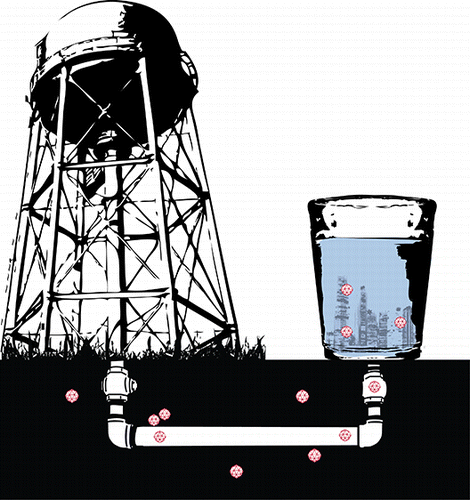New analysis of drinking water-related gastrointestinal illness

The distribution system piping in U.S. public water systems that rely on non-disinfected well water or "ground water" may be a largely unrecognized cause of up to 1.1 million annual cases of acute gastrointestinal illness (AGI), involving nausea, vomiting and diarrhea, scientists are reporting. Their study in ACS' journal Environmental Science & Technology concludes that such illnesses may become more of a problem as much of the nation's drinking water supply system continues to age and deteriorate.
Frank J. Loge, Mark A. Borchardt and colleagues explain that more than 100 million people in the U.S. rely on water piped into homes, schools and businesses from public water systems that get their water from wells, rather than lakes, rivers and other above-ground sources. Much of that water either is not disinfected at all or is not adequately disinfected to kill disease-causing viruses.
Their new analysis of the risk of AGI from these well-based water supply systems concluded that contamination of distribution system piping may be responsible for 470,000 to 1.1 million cases of AGI every year. They also warn that the incidence of AGI from public water systems is likely to rise in coming years: "So far insufficient financial investments have been made to improve water infrastructure, and small systems are particularly at risk for lack of funds and personnel. As most of the national water distribution infrastructure is reaching the end of its design life in the coming decades, the frequency and health impacts of distribution system deficiencies will likely worsen."
More information: "Risk of Viral Acute Gastrointestinal Illness from Nondisinfected Drinking Water Distribution Systems" Environ. Sci. Technol., 2012, 46 (17), pp 9299–9307. DOI: 10.1021/es3015925
Abstract
Acute gastrointestinal illness (AGI) resulting from pathogens directly entering the piping of drinking water distribution systems is insufficiently understood. Here, we estimate AGI incidence from virus intrusions into the distribution systems of 14 nondisinfecting, groundwater-source, community water systems. Water samples for virus quantification were collected monthly at wells and households during four 12-week periods in 2006–2007. Ultraviolet (UV) disinfection was installed on the communities' wellheads during one study year; UV was absent the other year. UV was intended to eliminate virus contributions from the wells and without residual disinfectant present in these systems, any increase in virus concentration downstream at household taps represented virus contributions from the distribution system (Approach 1). During no-UV periods, distribution system viruses were estimated by the difference between well water and household tap virus concentrations (Approach 2). For both approaches, a Monte Carlo risk assessment framework was used to estimate AGI risk from distribution systems using study-specific exposure–response relationships. Depending on the exposure–response relationship selected, AGI risk from the distribution systems was 0.0180–0.0661 and 0.001–0.1047 episodes/person-year estimated by Approaches 1 and 2, respectively. These values represented 0.1–4.9% of AGI risk from all exposure routes, and 1.6–67.8% of risk related to drinking water exposure. Virus intrusions into nondisinfected drinking water distribution systems can contribute to sporadic AGI.
Journal information: Environmental Science & Technology
Provided by American Chemical Society


















